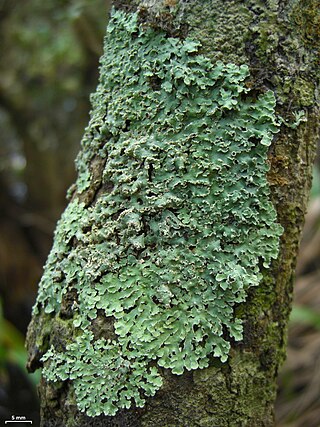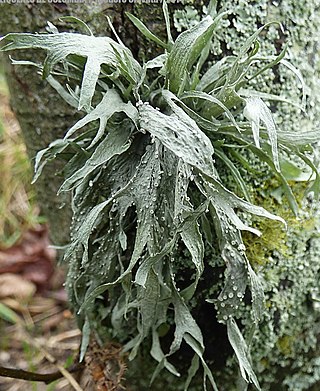
Ramalina is a genus of greenish fruticose lichens that grow in the form of flattened, strap-like branches. Members of the genus are commonly called strap lichens or cartilage lichens. Apothecia are lecanorine.
Kroswia is a genus of lichens in the family Pannariaceae. It consists of four paleotropical species: K. epispora, K. gemmascens, K. polydactyla, and the type, K. crystallifera. Species in the genus are characterized by their gelatinous, homoiomerous, and ecorticate thallus. The ascocarps contain terpenoids and fatty acids. The genus was circumscribed by Norwegian lichenologist Per Magnus Jørgensen in 2002.

Anaptychia is a genus of lichen-forming fungi in the family Physciaceae. Anaptychia species are foliose lichens. They have brown, thin-walled spores with a single septum, and a prosoplechtenchymatous upper cortex.

Pyxine is a genus of foliose lichens in the family Caliciaceae. The genus has a widespread distribution in tropical regions.

Physcia is a genus of lichen-forming fungi in the family Physciaceae. The widely distributed genus contains about 80 species. The genus is cosmopolitan, and has been extensively studied in various regions in the past several decades, with significant biodiversity in South America identified as a central diversity hotspot. Physcia species are foliose, lobate lichens that grow with a loose to close appressed habit. Their upper surface is typically whitish, pale greenish, green-grey, or dark grey in colour. The thallus colour remains relatively unchanged when moistened. Physcia lichens typically grow on bark, on wood, or rock, although they have occasionally been recorded dwelling on man-made structures. They thrive in nutrient-rich environments and are expanding rapidly in urban areas of the United Kingdom previously affected by SO2 pollution.
Hildur Krog was a Norwegian botanist.
Parmotrema aldabrense is a species of lichen in the family Parmeliaceae that is found in Africa. It was first described by Carroll William Dodge in 1959 as a species of Parmelia. Mason Hale transferred it to the genus Parmotrema in 1974. The type collection was made in the Aldabra Islands, where it was found growing on tamarind. It has also been recorded from Madagascar. The lichen has an olive-buff coloured thallus measuring up to 14 cm (5.5 in) in diameter.
Parmotrema amaniense is a species of corticolous lichen in the family Parmeliaceae. Found in Africa, the lichen was originally described by J. Steiner and A. Zahlbruckner as a species of Parmelia in 1926. The holotype collection was made in Usambara (Tanzania) at an elevation of 800 metres (2,600 ft). Krog & Swinscow transferred the taxon to Parmotrema in 1983. Secondary chemicals present in Parmotrema amaniense include alectoronic acid, protocetraric acid, and atranorin. In addition to Tanzania, it has been recorded in Uganda, Angola, Malawi, Mozambique, Sierra Leone, Zambia, and Zimbabwe.
Parmotrema apricum is a species of corticolous lichen in the family Parmeliaceae that is found in Africa. It was originally placed in the genus Parmelia by authors Hildur Krog and Dougal Swinscow in 1981. The holotype collection was made in the Machakos County, north of Kibwezi town in Kenya, where it was found growing on shrubs in a sun-exposed dry location. Two laters later, the authors transferred it to the genus Parmotrema.

Pyxine sorediata, commonly known as mustard lichen, is a widely distributed species of foliose lichen in the family Caliciaceae. It has a subtropical to warm temperate distribution, and grows on bark, rocks, and moss as substrates. Pyxine sorediata has been reported from regions of North America, Europe, Africa, Asia, and Australasia.

Punctelia appalachensis, commonly known as the Appalachian speckled shield lichen, is a species of foliose lichen in the family Parmeliaceae. It is found in the eastern United States and eastern Canada. The lichen was first formally described in 1962 by lichenologist William Culberson as a species of Parmelia. He collected the type specimen growing on tree bark in West Virginia, Hildur Krog transferred it to the newly circumscribed genus Punctelia in 1982.

Punctelia reddenda is a widely distributed species of foliose lichen in the family Parmeliaceae. It occurs in Africa, Europe, North America, and South America, where it grows on bark and on rock.

Punctelia punctilla is a species of foliose lichen in the family Parmeliaceae. It is found in Africa, South America, and North America, where it grows on bark and on rocks. The main characteristics that distinguish Punctelia punctilla from other species of Punctelia are the presence of isidia on the thallus surface, a pale brown thallus undersurface, and the presence of lecanoric acid in the medulla.

Punctelia hypoleucites, commonly known as the southwestern speckled shield lichen, is a species of foliose (leafy) lichen in the family Parmeliaceae. First formally described by Finnish botanist William Nylander as a species of Parmelia, it was transferred to the genus Punctelia in 1982. The lichen is found in Africa, North America, and South America, where it grows on the bark of both hardwood and coniferous trees. Its greenish-grey thallus is covered with tiny white pseudocyphellae – minute holes in the thallus surface that facilitate gas exchange. Some macroscopic features that help distinguish this species from other related members of the genus include the presence and the structure of the apothecia, the absence of asexual surface propagules, and the light brown color of the thallus undersurface. Chemically, the presence of lecanoric acid in the medulla and atranorin in the cortex help distinguish it from lookalikes.

Punctelia graminicola is a species of foliose (leafy) lichen in the family Parmeliaceae. It grows on rocks, and, less frequently, on bark in North America, South America, and East Africa. It has a blue-grey thallus measuring up to about 15 cm (6 in), covered with tiny pores called pseudocyphellae. Sometimes the lichen forms small lobes that project out from the surface. Fruiting bodies are uncommon in this species; if present, they resemble small cups with a brown internal disc measuring 3–10 mm (0.1–0.4 in) in diameter. A lookalike species, Punctelia hypoleucites, is not readily distinguishable from Punctelia graminicola by appearance or habitat alone; these species can only be reliably differentiated by examining the length of their conidia.
Pyxine lyei is a species of saxicolous (rock-dwelling), foliose lichen in the family Caliciaceae. Found in East Africa, it was scientifically described as a new species in 1975 by lichenologists Dougal Swinscow and Hildur Krog. The lichen has a whitish thallus that is tightly appressed to its substrate. The lobes comprising the thallus are flat, and have faint pseudocyphellae as well as patches of pruina. The thallus underside is black; the internal medulla is white. The lichen contains triterpenoid compounds as well as lichexanthone; the latter substance causes the lichen to fluoresce when lit with a long-wavelength UV light.
Pyxine katendei is a species of corticolous (rock-dwelling), foliose lichen in the family Caliciaceae. Found in East Africa, it was scientifically described as a new species in 1975 by lichenologists Dougal Swinscow and Hildur Krog. The lichen has a whitish to pale grey thallus that is tightly appressed to its substrate. The lobes comprising the thallus are somewhat convex; they lack pseudocyphellae, and have sparse pruina. The thallus underside is black; the internal medulla is white. The lichen contains triterpenoid compounds as well as lichexanthone; the latter substance causes the lichen to fluoresce when lit with a long-wavelength UV light.
Thomas Douglas (Dougal) Victor Swinscow (1917–1992) was the founder of the British Lichen Society and the scientific journal The Lichenologist. He was also a member of the editorial team of the British Medical Journal and deputy editor from 1964 until 1977.
Anaptychia ethiopica is a species of lichen in the family Teloschistaceae. Found in East Africa, China, and Russia, it was formally described as a new species in 1976 by lichenologists Thomas Douglas Victor Swinscow and Hildur Krog. The type specimen was collected from Mount Bwahit, where it was found growing on moss.

Ramalina celastri is a species of corticolous and lignicolous, fruticose lichen in the family Ramalinaceae. It is a widespread species with a pantropical distribution.










